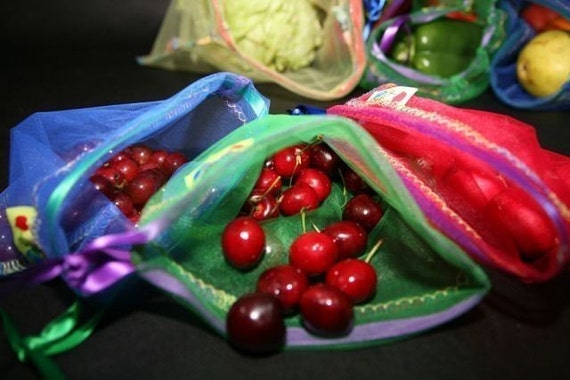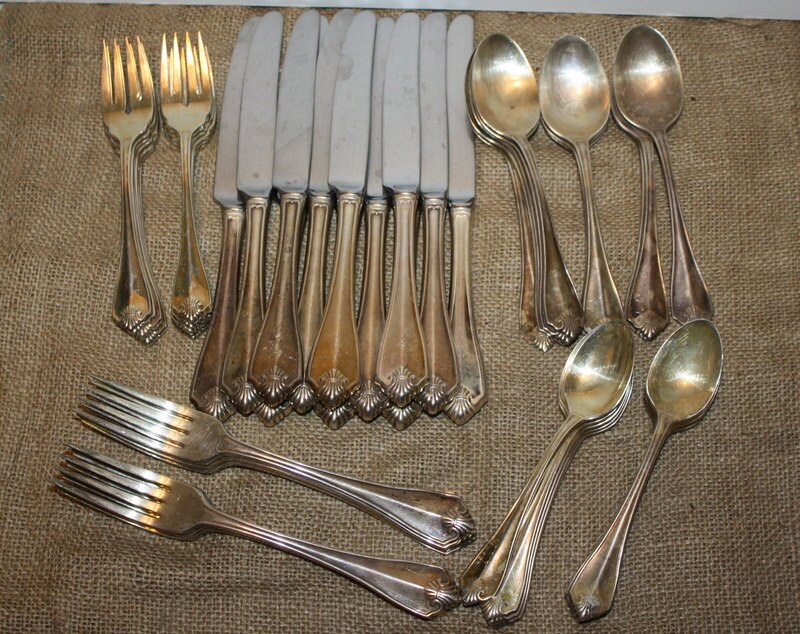My sissy is amazing. Recently she announced,
"I just bought re-usable cloth: napkins, produce & bulk bags...another step closer to being greener! AND made in the USA (even the materials!)"
She bought from an Etsy vendor LoveForEarth who lives in Virginia and focuses on eco-friendly alternatives, such as the cloth bags and napkins my sister bought from her. Even better, on LoveForEarth's Facebook page she announced an Earth Day special discount. My sister mentioned she had just missed the special, but loved her products, and guess what! The vendor applied the Earth Day discount retroactively and refunded her the savings!
I've been using cloth napkins for a while now, and my tip would be to get something in a multi-colored pattern. I have white napkins and black napkins, and the white napkins show stains too easily and the blank napkins show bits of lint that they pick up from the dryer. Of course, with the white napkins I can use bleach, but I try to only do that a few times per year, because bleach is so caustic.
Another dilemma I recently solved was in regards to silverware. We had previously been using an odd assortment of spoons, forks, and knives from at least 6 different sets.One of the things I had really wanted was a real, grown-up, silverware set to use (and not be embarrassed when we had company over).
I thought Oneida was still manufacturing in the US, but turns out they moved their production facilities to China back in the 90's. Boo! I looked and looked, but could only find one silverware maker in the US, but the were an online only store and had an extremely restricted return policy, so if I didn't like the set I bought, I would not be able to return it. Lame!
I end up searching on Etsy and found a vendor (AuctionJunkies) who was selling old Oneida sets (similar to the one pictured below). Even better! Originally made in the US, second hand, and now being bought from someone in Missouri. Yay!
Wednesday, April 17, 2013
Wednesday, April 10, 2013
Fish: It's what's for dinner!
The Question
I'm talking with my parents the other day, when they tell me about their latest dilemma. There they are in frozen food aisle at Trader Joe's looking at the frozen fish. There are several different types of salmon. In particular, they wondered, "Should we get the Atlantic salmon or the Pacific salmon?"
The Answer
Short answer: Pacific salmon.
Long answer: Soooo... I think we all know that the world's fish stocks are in pretty sad shape, what with overfishing, pollution, and global warming, so I will just assume that you, the reader, know why we should be mindful of which sorts of fish to eat. When considering what fish to eat, mostly I consider it from the environmental perspective of eating the most sustainably harvested fish. However some people, particularly children and pregnant women, need to think about this from a health perspective too, because some fish can contain high levels of mercury.
The most complete compendium I have found on what fish is good and bad is the Monterey Bay Aquarium's Seafood Watch. You can review it here. It very neatly lists which fish is "best choice," "good alternative," and "avoid." I printed out their pocket guides and have been using them for about 3 years now, since I became a pescatarian.The one complaint that I have about the Seafood Watch is that it is way too complete.
Here are some of the problems I have come across:
1. There is no way anyone can get all of the information needed to decipher the list. The most information you can get from food packages is the general type of fish (e.g., salmon, halibut, etc) and where it was caught (Pacific, Atlantic, etc). Sometimes you can get how is was raised or caught (e.g., farmed, line-caught), and very very rarely will you get the species (e.g., bluefin, yellowfin, skipjack, blackfin, bigeye, and albacore are all types of tuna). Oh, and let's not go it to the whole scandal about how much fish is mislabeled...
2. The guide is almost impossible to use when at a restaurant. The waiter is usually clueless, and long ago I gave up asking. I have even been to nice restaurants that list the location and harvesting method on the menu and still failed to be able to match it to what was on the list. Usually the lighting is too dark to clearly read the tiny font and I don't have my reading glasses with me. It is also kind of embarrassing. Do I really want to end up like the couple on Portlandia?
3. Then there is sushi, which means I have to translate first before reviewing my guide or use their separate sushi guide.
Solutions:
1. The Seafood Watch people also have a Super Green list, advertised as a short list of fish that is good for your health and the environment. This list is short, and, did I mention, short? Also, or actually because of that, it is easy to decipher.
2. Really I'm to the point where I've just memorize the 3 main types of fish I like and that are okay to eat: Pacific salmon, Pacific halibut, US tuna, and US catfish. And if I'm out at a restaurant, then sometimes that means going with the vegetarian dish.
3. I just found out that they have turned Seafood Watch into an Android app! I'm downloading it today and hopefully can give some feedback on it soon! Yay!
I'm talking with my parents the other day, when they tell me about their latest dilemma. There they are in frozen food aisle at Trader Joe's looking at the frozen fish. There are several different types of salmon. In particular, they wondered, "Should we get the Atlantic salmon or the Pacific salmon?"
The Answer
Short answer: Pacific salmon.
Long answer: Soooo... I think we all know that the world's fish stocks are in pretty sad shape, what with overfishing, pollution, and global warming, so I will just assume that you, the reader, know why we should be mindful of which sorts of fish to eat. When considering what fish to eat, mostly I consider it from the environmental perspective of eating the most sustainably harvested fish. However some people, particularly children and pregnant women, need to think about this from a health perspective too, because some fish can contain high levels of mercury.
The most complete compendium I have found on what fish is good and bad is the Monterey Bay Aquarium's Seafood Watch. You can review it here. It very neatly lists which fish is "best choice," "good alternative," and "avoid." I printed out their pocket guides and have been using them for about 3 years now, since I became a pescatarian.The one complaint that I have about the Seafood Watch is that it is way too complete.
Here are some of the problems I have come across:
1. There is no way anyone can get all of the information needed to decipher the list. The most information you can get from food packages is the general type of fish (e.g., salmon, halibut, etc) and where it was caught (Pacific, Atlantic, etc). Sometimes you can get how is was raised or caught (e.g., farmed, line-caught), and very very rarely will you get the species (e.g., bluefin, yellowfin, skipjack, blackfin, bigeye, and albacore are all types of tuna). Oh, and let's not go it to the whole scandal about how much fish is mislabeled...
2. The guide is almost impossible to use when at a restaurant. The waiter is usually clueless, and long ago I gave up asking. I have even been to nice restaurants that list the location and harvesting method on the menu and still failed to be able to match it to what was on the list. Usually the lighting is too dark to clearly read the tiny font and I don't have my reading glasses with me. It is also kind of embarrassing. Do I really want to end up like the couple on Portlandia?
3. Then there is sushi, which means I have to translate first before reviewing my guide or use their separate sushi guide.
Solutions:
1. The Seafood Watch people also have a Super Green list, advertised as a short list of fish that is good for your health and the environment. This list is short, and, did I mention, short? Also, or actually because of that, it is easy to decipher.
2. Really I'm to the point where I've just memorize the 3 main types of fish I like and that are okay to eat: Pacific salmon, Pacific halibut, US tuna, and US catfish. And if I'm out at a restaurant, then sometimes that means going with the vegetarian dish.
3. I just found out that they have turned Seafood Watch into an Android app! I'm downloading it today and hopefully can give some feedback on it soon! Yay!
Subscribe to:
Posts (Atom)

